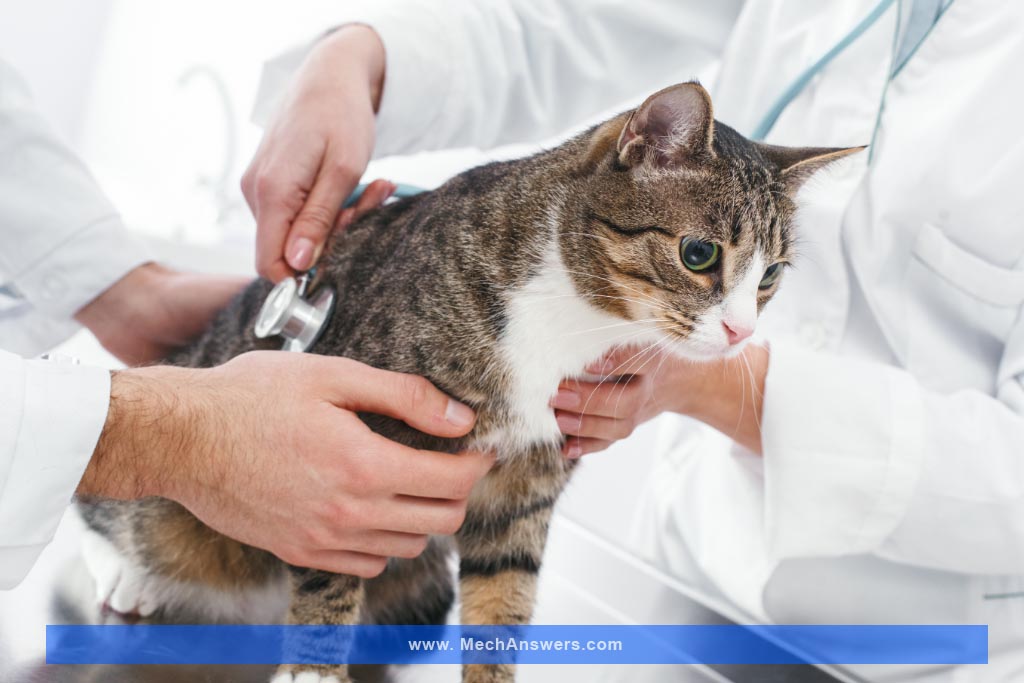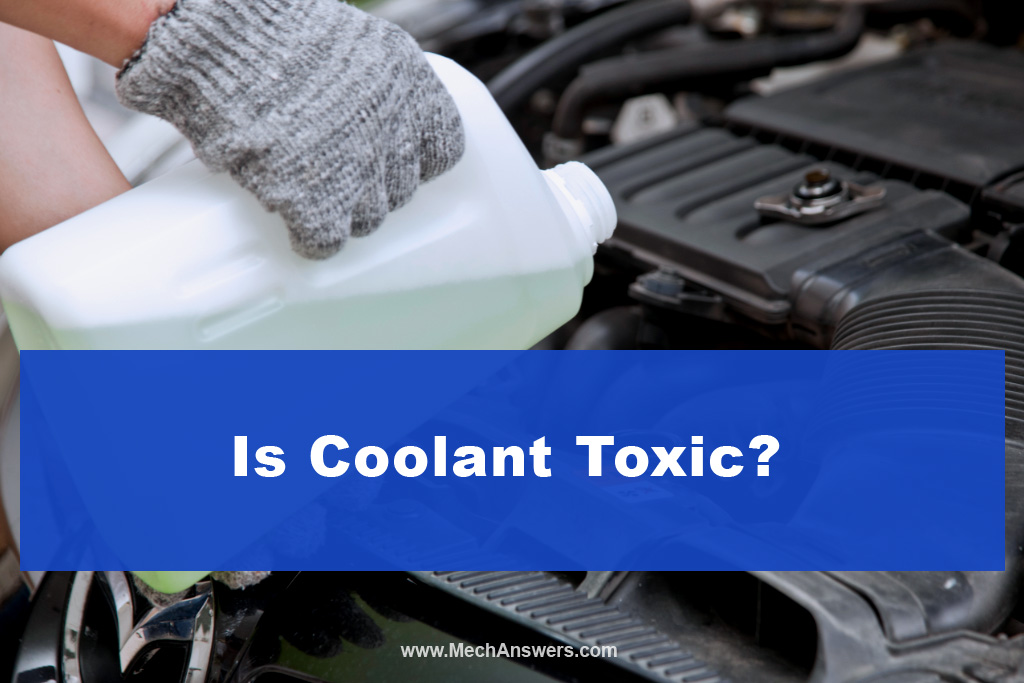Ever found yourself searching the internet for answers to the question, “Is Coolant Toxic?” If so, then this is just the article for you.
So, what exactly is the answer to “Is Coolant Toxic?” Yes, it indeed is. Coolant, also known as antifreeze, is highly toxic to both humans and pets. If ingested or in some cases even touched, it can lead to serious health complications.
This article will provide an in-depth look into the symptoms and effects of coolant poisoning in both humans and pets. Knowing this information is crucial, as it can potentially help in preventing serious health hazards in your household.
Table of Contents
Coolant Can Become Dangerous
Importance of Handling Car Coolant Properly
Car coolant, also known as antifreeze, is a liquid compound used to keep car engines from overheating. When handled properly, car coolant is not dangerous for humans.
However, it is important to note that car coolant can become dangerous if it is not handled properly. If the glycol and water are mixed in incorrect proportions, the resulting compound may not be non-toxic.
Additionally, car coolant is typically dyed either green or pink in order to make it easier to detect if it has been mixed with other liquids. If the coolant is not dyed properly, it may be difficult to detect if it has been tampered with or mixed with another substance.
Potential Toxicity of Car Coolant
In addition to the potential toxicity of car coolant, it can also be dangerous if it is ingested or comes into contact with the eyes.
Car coolant is corrosive and can cause severe irritation to the skin and eyes. Therefore, it is important to take the necessary precautions when handling car coolants, such as wearing protective gloves and eyewear.
Safety Precautions for Handling Car Coolants
Car coolant is generally safe for humans when handled correctly. However, it is important to take the necessary precautions to ensure that the coolant is mixed correctly and that it is not ingested or comes into contact with the eyes.
Additionally, it is important to pay attention to the color of the coolant and make sure it is properly dyed. By taking these steps, car coolant can be a safe and effective tool for keeping your car engine running at the ideal temperature.
What Happens If You Got Coolant In Your Mouth?
When coolant gets into your mouth, it can cause irritation, burning, and inflammation. In severe cases, it can lead to difficulty breathing, coughing, vomiting, and even coma. It is important to seek medical attention immediately if you have ingested coolant.
The coolant itself is made up of several chemicals, such as ethylene glycol and propylene glycol. These chemicals can have a variety of adverse effects on the body, including nausea, dizziness, and even kidney damage. In addition, they can cause chemical burns in the throat, mouth, and stomach if ingested.
If you happen to get coolant in your mouth, it is important to rinse it out immediately with water. This should be done immediately, as coolant can be toxic if consumed.
It is important to rinse your mouth out for at least two minutes to ensure that all traces of coolant have been removed. If you have swallowed any of the coolants, it is important to drink plenty of water to help flush it out of your system.
Once you have rinsed your mouth out, it is important to seek medical attention. You should call your doctor or visit the nearest emergency room as soon as possible. In addition to rinsing your mouth out, your doctor may prescribe medication to help flush the coolant from your system.

What Happens If You Got Coolant Splashed In Your Eyes?
It is important to be aware of the possible consequences of getting coolant splashed in your eyes. Coolant is usually a combination of glycol, water, and sometimes other chemicals like alcohol or sodium chloride. While the coolant is not toxic, it can be extremely irritating to the eyes.
If you get coolant splashed into your eyes, the most important thing to do is to flush the eyes out immediately with plenty of clean water. This can be done using an eye wash station, or by continually flushing the eyes with a steady stream of water from a tap or faucet.
You should flush your eyes for at least 15 minutes, or until the irritation or burning sensation has gone away.
Once you have flushed your eyes, it is important to seek medical attention. Coolant can cause a variety of eye problems such as irritation, redness, tearing, and blurred vision.
If left untreated, these problems can worsen and lead to long-term problems. A doctor or eye specialist can diagnose and treat any eye problems caused by coolant.
It is also important to identify the source of the coolant, especially if you have been splashed with it in the workplace. Coolant should be handled with care, as it can cause serious eye injury if it is not handled properly.

Is Coolant Toxic To Breathe?
When coolant evaporates, it releases toxic vapors that can be dangerous when inhaled. The most common hazard is to the respiratory system, as these vapors can irritate the lungs and cause shortness of breath.
In extreme cases, exposure to high levels of coolant can lead to unconsciousness and even death due to asphyxiation. It is also possible for coolant to seep into the ground and contaminate the local water supply.
If ingested, the chemical compounds in the coolant can cause serious health problems, such as kidney and liver damage. Additionally, ethylene glycol in the coolant can be toxic to aquatic organisms and other animals.
Fortunately, there are several ways to reduce the risk of coming into contact with coolant. If you own a car, make sure to check the coolant levels regularly and top off when necessary.
Additionally, if you work on vehicles or use coolant in any way, it is important to wear protective gear and a respirator to avoid inhaling the vapors.
In the event that you do breathe in coolant vapors, it is important to get to fresh air as soon as possible. If symptoms such as dizziness, nausea, or shortness of breath persist, seek medical attention immediately.
Human Antifreeze Poisoning Symptoms?
The symptoms of human antifreeze poisoning may vary depending on the individual, but they generally include a range of gastrointestinal, neurological, and cardiovascular issues.
Gastrointestinal symptoms may include nausea, vomiting, abdominal pain, and diarrhea.
Neurological symptoms may include confusion, dizziness, slurred speech, and decreased reflexes.
Cardiovascular symptoms may include rapid or irregular heartbeat, low blood pressure, and cardiac arrest.
The most common symptom of antifreeze poisoning is the presence of a sweet-tasting substance in the mouth. This is due to antifreeze containing ethylene glycol, a compound that can be detected in the saliva of those who have ingested it.
In more serious cases of antifreeze poisoning, a person may experience seizures, coma, and even death. If antifreeze is swallowed, it is important to seek medical attention as soon as possible.
Treatment for antifreeze poisoning usually involves the use of a drug called fomepizole, which is used to block the body’s ability to metabolize the ethylene glycol in antifreeze.
Here are some common poisoning symptoms:
1. Abdominal pain: Abdominal pain is the most common symptom of human antifreeze poisoning. It can range from mild to severe.
2. Nausea and vomiting: Nausea and vomiting are also common symptoms of antifreeze poisoning.
3. Confusion: Confusion and disorientation are common in people who have been poisoned by antifreeze.
4. Seizures: Seizures are a serious symptom of antifreeze poisoning. They can be mild or severe and can lead to coma or death if not treated quickly.
5. Weakness and fatigue: Weakness and fatigue are common symptoms of antifreeze poisoning.
6. Slurred speech: Slurred speech is a common symptom of antifreeze poisoning.
7. Difficulty breathing: Difficulty breathing is another symptom of antifreeze poisoning.
8. Vision problems: Vision problems, such as blurred vision and double vision, are common in people who have been poisoned by antifreeze.
9. Unconsciousness: Unconsciousness is a serious symptom of antifreeze poisoning and can lead to coma or death if not treated quickly.
10. Coma: Coma is a serious symptom of antifreeze poisoning and can lead to death if not treated quickly.
Is Coolant Toxic To Pets / Animals?
Dangers of Ingesting Coolant for Animals
The answer is yes. Coolant is made up of a mixture of antifreeze and water, and antifreeze is extremely toxic to both humans and animals.
Ingesting even a small amount can cause serious illness and even death. The toxins prevent the oxygen-carrying pigment in the blood from binding with oxygen, leading to organ failure. Additionally, antifreeze has a sweet taste, making it appealing to animals.
Storing Coolant Safely to Protect Animals
It is important to always store coolant in a safe place away from animals and to keep it tightly sealed. If an animal does ingest coolant, it is important to get them to a veterinarian as soon as possible.
Treatment may include medications to help the animal eliminate the toxins from their body, as well as fluids and electrolytes to replace what has been lost.
Treatment for Animals Ingesting Coolant
In addition to the dangers posed by ingesting coolant, animals can also be harmed by coming into contact with it.
If the coolant is spilled, it can cause discomfort and skin irritation. In severe cases, it can cause severe burning and blistering. If this occurs, the animal should be cleaned with mild soap and water, and then taken to a veterinarian for further treatment.
Potential Harm from Coming into Contact with Coolant for Animals
Coolant is toxic to animals and should be stored in a safe place away from them. If an animal does ingest coolant or comes into contact with it, medical attention should be sought immediately.
By taking proper precautions and exercising caution when handling coolant, we can help keep our animals safe and healthy.
Dog Antifreeze Poisoning Symptoms?
Dog antifreeze poisoning is a serious health concern for pet owners. Dogs are often drawn to the sweet taste of antifreeze and can easily become poisoned if exposed to the liquid. It is important for pet owners to be aware of the symptoms of antifreeze poisoning in order to act quickly and seek medical attention for their pets.
Excessive thirst and urination
The most common symptom of antifreeze poisoning in dogs is excessive thirst and urination. If a dog has ingested antifreeze, it may begin drinking and urinating more than usual.
They may also have a sweet smell to their breath and urine. Other symptoms of antifreeze poisoning in dogs include vomiting, diarrhea, and loss of appetite.
Seizures, lethargy, disorientation…
More serious signs of antifreeze poisoning in dogs include seizures, lethargy, disorientation, and difficulty breathing. These symptoms can occur soon after ingestion and can be life-threatening if left untreated. If a dog is exhibiting any of these symptoms, it should be taken to a veterinarian immediately.
In some cases, signs of antifreeze poisoning may not be immediately evident. The toxin in antifreeze can cause damage to the dog’s kidneys, leading to a buildup of toxins in the blood. This can cause fatigue, lack of appetite, and weight loss. If untreated, the toxins can lead to kidney failure and death.
Dog owners should take care
Dog owners should take all necessary precautions to ensure that their pet does not come into contact with antifreeze.
It is important to be aware of the symptoms of antifreeze poisoning so that it can be treated quickly if it does occur. If a pet is showing any of the symptoms listed above, it should be taken to a veterinarian immediately for treatment.

Cat antifreeze poisoning symptoms?
Cat antifreeze poisoning is a serious and potentially fatal condition for cats. It occurs when cats ingest antifreeze, either accidentally or intentionally.
Antifreeze contains ethylene glycol, a toxic chemical that can be deadly if ingested by cats.
Knowing the symptoms of antifreeze poisoning can help owners recognize the condition and seek immediate veterinary attention.
Vomiting, lethargy, loss of coordination…
The most common symptom of antifreeze poisoning is excessive thirst. Cats may drink more water than usual, and they may also urinate more frequently.
Other symptoms of antifreeze poisoning include vomiting, lethargy, loss of coordination, and seizures. If the cat has been exposed to large amounts of antifreeze, the symptoms may be more severe and can even lead to coma and death.
In addition to these physical symptoms, cats with antifreeze poisoning may also exhibit behavioral changes. These can include agitation, restlessness, and even aggression. In some cases, cats may be disoriented and unable to recognize their owners.
Antifreeze poisoning can be difficult to diagnose
Antifreeze poisoning can be difficult to diagnose, as the symptoms may be similar to other illnesses. If a cat is displaying any of the above symptoms, it is important to take the animal to the veterinarian immediately.
In some cases, a diagnosis can be made from a physical examination and a review of the cat’s medical history. In other cases, a blood test may be needed to confirm the diagnosis.
If antifreeze poisoning is diagnosed early, treatment may be successful. Treatment typically involves administering drugs to counteract the toxic effects of ethylene glycol, as well as providing supportive care such as IV fluids and oxygen. In some cases, the cat may need to be hospitalized for a few days.

Is There A Non-Toxic Antifreeze?
Fortunately, there are now non-toxic types of antifreeze available. These antifreeze are made from propylene glycol instead of ethylene glycol.
Propylene glycol is a much safer chemical that is used in many food and cosmetics products. It does not pose a risk to humans or animals, and it does not pose a threat to the environment.
Non-toxic antifreeze can be used in both diesel and gasoline engines. It provides the same protection as traditional antifreeze but without the potential hazards. It is also much more efficient at transferring heat, which can help reduce engine wear and tear.
Non-toxic antifreeze is available in both concentrated and ready-to-use formulations. The concentrated form requires dilution before use, while the ready-to-use version is ready to be poured into the radiator. It is important to use the correct amount of antifreeze, as too much can actually reduce its efficiency.
Time to Strike Antifreeze Off Your List of Usable Poisons >> Check out the video below:
Related Articles
Read more >> No Leak, No Overheating: 12 Causes of Losing Coolant
Read more >> Can The Wrong Oil Cause Overheating? Simply Explained
Read more >> How Much & When Is It Normal For The Coolant Level To Drop?
Conclusion
In conclusion, coolant is generally considered to be non-toxic and safe for use in most automotive applications.
However, it is important to take precautions when working with coolant, such as wearing protective clothing and gloves and avoiding contact with skin and eyes.
Additionally, it is important to make sure the coolant used is approved for the specific application and is in good condition. Taking these precautions can help to ensure that coolant is used safely and correctly.
Reference Source:
https://www.medicalnewstoday.com/articles/324807

